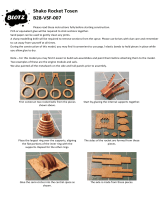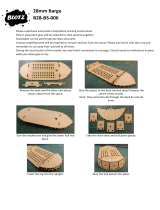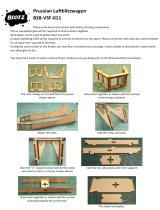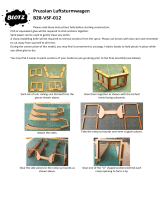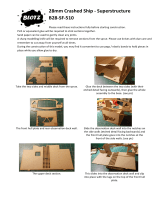Page is loading ...

Build the largest warship of the 17th century
HMS
1
PACK
TM

All rights reserved © 2014
Published in the UK by De Agostini UK Ltd.
Battersea Studios 2, 82 Silverthorne Road,
Battersea, London SW8 3HE
Published in the USA by
De Agostini Publishing USA Ltd,
915 Broadway, Suite 609,
New York, NY 10010
Contents
ASSEMBLY GUIDE
3 Stage 1: First parts of the hull and a cannon
6 Stage 2: Two rib frames of the forward hull and a cannon
9 Stage 3: The central section of the false keel, rib frames
and an anchor
12 Stage 4: Two central rib frames, two bow formers and
making the first four blocks
15 Stage 5: Lengthening the keel and fitting blocks
to the cannon
18 Stage 6: Two rib frames and making the blocks for a cannon
21 Stage 7: Rib frame, stern false keel and bracing pieces
24 Stage 8: Begin to build the ship’s launch
27 Stage 9: Fitting the last two frames to the stern
30 Stage 10: The bowsprit and the strakes of the launch
33 Stage 11: The lower deck and the strakes of the launch
Build the largest warship of the 17th century
HMS
www.model-space.com
WARNING: Not suitable for children under the age of 14. This product is not a toy and is
not designed or intended for use in play. Items may vary from those shown.
TM

2 Position and glue the second bow
former support 3 to the forward bulkhead
2, ensuring that it aligns with the bow
former support you fixed in Step 1.
3 Position and glue one of the bow
formers 4 to the forward bulkhead 2.
Follow the white arrows in the photo.
A Bow false keel (1)
B Forward bulkhead (2)
C Bow former supports x 2 (3)
D Bow formers x 2 (4)
E Gun carriage (201C, 202C,
203C, 204C)
F Gun carriage wheels x 2 (215C)
G Eyebolts x 4 (208C)
H Blocks x 4 (209C)
I Wheel axle (205C)
J Barrel (206C)
K Trunnion cap squares x 2 (207C)
L Steel wire
M Brown cotton thread (diam. 0.15mm)
1 Using PVA wood glue, position and
x one of the bow former supports 3 in
the hole marked 3 on the forward
bulkhead 2, as indicated by the white
arrow in the photo.
Stage 1: First parts of the hull
and a cannon
A
C
D
F
G
I
J
K
L
M
E
B
1
32
H
YOU WILL NEED
O PVA wood glue
O Tweezers
O Craft knife
O Sandpaper
O Superglue
O Side cutters
O Airbrush or paintbrush
O Primer
O Red, black and dark
bronze modelling paint
3
A
S
S
E
M
B
L
Y
G
U
I
D
E

4
A
S
S
E
M
B
L
Y
G
U
I
D
E
7 Here’s how it should look so far. The false keel 1 must be at a
right angle to the plane of the forward bulkhead assembly.
7
8
8 Use a craft knife to cut out the pieces 201C, 202C and 203C
of the gun carriage E. If necessary, remove any irregularities that
occur at the points where the pieces were attached.
8
4
4 Repeat the process with the second bow former 4, gluing it to
the forward bulkhead 2, as shown in the photo.
4
90°
5
5
5 Each bow former 4 must make a right angle with the plane of
the forward bulkhead 2. A gap of 4mm must remain between the
two bow formers.
9
9 Glue the gun carriage base 202C to the gun carriage side
201C, as shown in the photo.
4mm
6
6
6 Take the bow false keel 1 and dry mount it on the
forward bulkhead assembly.

11 Position and glue the connecting strip 204C in the slots of
pieces 201C and 203C. Cut the ends ush with a craft knife and
lightly sand them to remove any irregularities.
11
14 If you opt for a painted nish, prime the wheels then paint
them black. Slip them on the axle and x with superglue on both
sides of the gun carriage. Cut the axle to length with side cutters.
14
10
10 Complete the gun carriage E by gluing piece 203C to the gun
carriage base 202C so that it mirrors the position of 201C and the
result is symmetrical.
13
13 Insert the wheel axle 205C into the holes of pieces 201C and
203C, as shown in the photo.
12
12 If you want a fully painted model, it’s sensible to paint small
parts at an early stage. Apply a coat of primer, then use an airbrush
or ne brush to paint the gun carriage with red modelling paint.
15
15 To complete the decoration, prime then paint the barrel a
dark bronze colour. Set it on the gun carriage and x it with the
trunnion cap squares 207C using superglue.
5
A
S
S
E
M
B
L
Y
G
U
I
D
E

2 Fit and glue the second bow former
8 to the forward bulkhead 2, in the
same way. It should be in a symmetrical
position to the one you have just tted.
3 Take rib frame 5 and glue rib frame
5a to its left edge lug, as shown. Make
sure that it ts in the slot and is ush
with the rib frame’s surface.
A Rib frame (6)
B Rib frame (5)
C Two rib frames (5a and 5b)
D Two rib frames (6a and 6b)
E Two bow formers (8)
F Gun carriage
(210C, 211C, 212C and 214C)
G Gun carriage wheels x 4 (215C)
H Wheel axles (205C) x 2
I Trunnion cap squares x 2 (207C)
J Blocks x 6 (209C)
K Cannon barrel (213C)
L Eyebolts x 6 (208C)
M Cotton thread (diam. 0.5mm)
1 Take a bow former 8 and glue it to the
forward hull assembly at right angles, as
shown in the photo.
Stage 2: Two rib frames of the
forward hull and a cannon
A
CD
F
G
K
J
H
L
M
E
B
1
32
I
YOU WILL NEED
O PVA wood glue
O Tweezers
O Superglue
O Side cutters
O Airbrush or paintbrush
O Primer and red, black and
dark bronze modelling paint
6
A
S
S
E
M
B
L
Y
G
U
I
D
E

7 Now t and glue rib frame 6 to the bow false keel 1 in the same
way, setting it into the slot immediately to the right of the previous
rib frame. Here is how it should look so far.
7
8
4
4 Glue rib frame 5b to the opposite edge of rib frame 5, in a
position mirroring that of 5a.
45
5 Repeat the operations on the other rib frame 6, xing the
rib frames 6a and 6b to its opposite sides.
9
9 Now, glue the opposite edge of the base 211C to the other
side of 212C; it must be parallel and symmetrical to 210C, as
shown above.
6
8 Free the gun carriage pieces from their frame – they may need
a very light sanding. Glue an edge of the base 211C to the side of
210C, as shown in the photo, making sure not to cover the holes.
6 Now x rib frame 5 to the bow false keel 1, inserting it into
the slot indicated by the white arrow. Do not glue the rib frames 5
and 6 if you want to make the assembly jig for HMS Sovereign of
the Seas as will be shown in Stage 3.
7
A
S
S
E
M
B
L
Y
G
U
I
D
E

Glue two wheels at opposite ends of the axle. Use side cutters
to snip the axle down to size.
11
14 Prime and paint the wedge 214C red and the barrel 213C
dark bronze. Fix it to the carriage with superglue, as shown in the
photo above.
14
10
10 Assuming you wish to paint your model, prime then paint the
carriage red and the wheels 215C black. en, insert one of the
axles 205C into the rear holes.
13
13 Free the small support wedge 214C from its frame and
glue it in the middle of the base 211C in the position shown.
12
12 Repeat the previous two steps, inserting the other axle
205C into the front holes and mounting the remaining
two wheels 215C.
15
15 Fix the trunnions of the barrel using the two trunnion cap
squares 207C. Take three eyebolts 208C, shorten the stems and
glue them in the positions on the gun carriage as shown above.
11
8
A
S
S
E
M
B
L
Y
G
U
I
D
E

2 Fit the temporary support that you
have just made between the bow formers
of the assembly, as shown by the white
arrows in the photo. DO NOT USE
GLUE!
3 Carefully glue the central section of
the false keel 9 to the end of the forward
false keel 1.
A Central section of the false keel (9)
B Rib frame (7)
C Two rib frames (7a and 7b)
D Two bow formers (11)
E Mast housing (14)
F Two bracing pieces (10)
G Pieces for temporary support of the keel
(C1 and C2)
H Anchor (216C)
I Wooden strip for the anchor stock (217C)
J Ring of the anchor shank (218)
K Black thread (diam. 0.15mm)
Take pieces C1 and C2. Dab a little
glue into one of the slots and then t them
together. ey must be set at perfect right
angles to one another.
Stage 3: The central section
of the false keel, rib frames
and an anchor
A
C
D
F
F
GG
HK
J
E
B
1
32
I
YOU WILL NEED
O PVA wood glue
O Superglue
O Flat metal le
O Round le
O Airbrush or
paintbrush
O Craft knife
O Saw
O Fine sandpaper
O Clamps
O Pliers x 2
O Metal primer
O Black modelling
paint
1
9
A
S
S
E
M
B
L
Y
G
U
I
D
E

7 Glue piece 14 (to become the mast housing) in the slot marked
on the false keel. Again, the two pieces must form a right angle.
7
8
4
4 Glue the bracing pieces 10 on opposite sides of the false keel at
the join between pieces 1 and 9. Hold them with a clamp, making
sure that they do not cover the slots for the rib frames.
45
5 Complete rib frame 7, tting and gluing the two
symmetrical rib frames 7a and 7b into its side slots,
as in previous steps.
9
9 Glue the second bow former 11 on the opposite side of the
bulkhead, in a symmetrical position to the previous one.
6
6
6 Glue rib frame 7 to the forward section of the false keel, xing
it in the corresponding slot. Make sure that it sets at a right angle
to the false keel 1.
8 You now need the two bow formers 11: glue the rst in the
relevant slot of the forward bulkhead 2, as shown in the photo.
10
A
S
S
E
M
B
L
Y
G
U
I
D
E

11 Take the wooden strip 217C and cut it into four pieces with a
craft knife or small saw, following the measurements shown above.
Smooth out any irregularities with a flat file.
11
14 Using the measurements shown above as a guide, wrap 0.15mm
black thread around the stock of the anchor to make four rope
bindings. Secure the thread by putting a tiny drop of PVA glue
into the bindings; rub it gently with a nger and leave to dry.
Use a very sharp craft knife to cut o any excess thread.
14
10
10 Use a metal le to remove any irregularities on the anchor 216C.
If you are opting for a painted nish, spray or paint on a coat of metal
primer; when dry, colour the anchor with black modelling paint.
13
12
15
15 Finally, gently open the ring 218 with two pairs of pliers, then
pass it through the eye in the anchor’s shank. Close the ring using
the pliers again. Your anchor is now complete.
26mm
8mm
3mm
3mm
26mm 55mm 55mm
1mm
1mm
12 Glue the two shorter pieces of wood onto the longer one
so that they form a central slot, as you can see above. When
the glue has set, place the remaining length of wooden strip
alongside it. Run a round le across both pieces, using the
existing slot as a guide. is way you will make two matching
slots in exactly the same position. e slot needs to be the
same width as the shank of the anchor, so check that it will t.
13 Mark the centre of each slotted piece, and make two more
marks 1mm up from the bottom of each end. Draw lines to
join the three points together. Sand away the small lower area.
Dab a drop of superglue in the slot and insert the anchor. It
is essential that the stock is mounted at a right angle to the
anchor ukes. Glue the two parts of the stock together with
PVA wood glue. When dry, smooth with ne sandpaper. Clean
o any excess glue, then place the assembly in a clamp to set.
MAKING THE ANCHOR
11
A
S
S
E
M
B
L
Y
G
U
I
D
E

2 Spread glue on the
toothed edge of one of the
bow formers 12, as shown
in the photo.
3 Fix the bow former to
the forward bulkhead 2,
as indicated by the white
arrows. Before continuing,
make sure that the two
pieces form a right angle
to one another.
A Rib frame (13)
B Rib frames (13a and 13b)
C Rib frame (15)
D Rib frames (15a and 15b)
E Two bow formers (12)
1 Take the keel so far
assembled, and the two
bow formers marked with
the number 12.
Stage 4: Two central rib frames,
two bow formers and making
the first four blocks
A
C
D
E
B
32
1
YOU WILL NEED
O PVA wood glue
O Sandpaper
O Hand drill and
1mm drill bit
O Tweezers
O Pliers
12
A
S
S
E
M
B
L
Y
G
U
I
D
E

7 Glue the assembled rib frame 13 to the central section of the
false keel 9, as shown in the photo, making sure that the two pieces
form a right angle.
7
8
4
4 Repeat the operation with the second bow former 12, tting
and gluing it to the relevant place in the forward bulkhead 2,
keeping it at right angles to the bulkhead.
45
5 Take pieces 13, 13a and 13b: t and glue rib frame 13a to
the left edge of rib frame 13, as shown in the photo.
9
9 Glue rib frame 15 into the relevant slot of the central section 9
of the false keel, taking care to keep the two pieces at right angles.
6
6
6 Similarly, t and glue the other rib frame 13b on the opposite
edge of rib frame 13.
8 Repeat the operation with rib frame 15: t and glue rib frames
15a and 15b to their respective edges, as shown in the photo.
90°
13
A
S
S
E
M
B
L
Y
G
U
I
D
E

11 Before tting the blocks with the wire, we suggest cleaning
up the holes with a hand drill tted with a ne bit. You can then
nish the surface with ne sandpaper.
11
14 Repeat the operation with the second pair of blocks, without
cutting the lower ends of the wire. e drawings above show you
how to do this.
14
10
10 Take the four blocks 209C, steel wire and eyebolts 208C that
you received with Stage 1. e following drawings illustrate the
technique for dressing the blocks.
13
13 Fit the wire to the block by passing the two loose ends of
the wire along the long edges, then twist the ends with pliers
and remove the surplus. Complete two blocks in this way.
12
12 Cut a 50mm-long piece of the wire, then, using a wooden rod
or a 1mm drill bit, make a loop in the centre of the wire, as shown
in the photo.
15
15 Create a second lower loop on these two blocks, as shown in
the drawing; again, cut o the surplus and keep all the pieces for
future stages of the assembly.
78
78
MAKING THE BLOCKS FOR A CANNON
14
A
S
S
E
M
B
L
Y
G
U
I
D
E

A Section of false keel (17)
B Rib frame (16)
C Two rib frames (16a and 16b)
D Two bracing pieces (18)
E Mast housing (19)
A
CD
E
B
1
3
2
4
1 Take the keel assembled so far and t and glue the left edge of
the central section of the false keel 17, as shown in the photo.
3 On the part of the keel so far assembled, check (and if needs
be adjust) the alignment of all the pieces; in particular, check the
rib frames.
2 Glue the two bracing pieces 18 to the keel, at the junction
between the pieces 9 and 17, holding them in place with clamps
and without overlapping the lateral slots.
4 Now, complete rib frame 16: following the usual procedure,
t and glue rib frame 16a to its left edge, as shown in the photo.
Stage 5: Lengthening the keel and
fitting blocks to the cannon
YOU WILL NEED
O PVA wood glue
O Clamps
O Side cutters
O Superglue
O Pliers
15
A
S
S
E
M
B
L
Y
G
U
I
D
E

8 You can now t and glue the mast housing 19 in slot 17 of the
false keel. Check that the two pieces form a right angle.
8
9
5 Similarly, t and glue the other rib frame 16b to the right edge
of rib frame 16, which must mirror the rst.
56
6 Glue frame 16 in the free slot of the false keel section 9,
making sure, as usual, that the two pieces meet at right angles.
10
10 After opening the eye of one of the four eyebolts 208C with
pliers, t it to one of the blocks 209C with a single ring.
7
7 Take the mast housing 19 (which will form the base of a mast)
and apply glue along its lower slot, as shown in the photo.
9 Take the four blocks 209C, completed in the assembly phase
described in Stage 4, and four eyebolts 208C received with your
rst stage.
16
A
S
S
E
M
B
L
Y
G
U
I
D
E

12 With side cutters, shorten by about 2mm both stems of the
eyebolts 208C that you have connected to the two blocks 209C.
12
15 Working in the same manner, t and glue the shortened stem
of the other eyebolt 208C in the hole on the opposite side of the
cannon.
15
11
11 Close the eyelet of eyebolt 208C with pliers. en repeat the
operation with the other block 209C with a single ring.
14
14 Glue the stem of the trimmed eyebolt 208C in the hole
on the right side of the cannon.
13
13 Take the cannon made in Stage 2 and drill a hole in
each side in the position shown in the photo.
16
16 Fit the other two eyebolts 208C pieces to blocks 209C that
have double rings. Choose the one nearest to the hole. Keep these
two pieces for future assembly.
2mm
6mm
17
A
S
S
E
M
B
L
Y
G
U
I
D
E

1
3
2
4
1 As in previous steps, you are going to make and t another rib
frame, beginning with parts 20, 20a and 20b.
3 After applying glue to the right edge of rib frame 20, t and
x the other rib frame 20b.
2 Following the usual procedure, t and glue the rst rib frame
20a on the left edge of rib frame 20.
4 Spread glue along the bottom slot of rib frame 20 before you
x it, like earlier frames, to the false keel so far assembled.
A Two rib frames (20a and 20b)
B Two rib frames (21a and 21b)
C Rib frame (20)
D Rib frame (21)
Stage 6: Two rib frames and
making the blocks for a cannon
BA C D
YOU WILL NEED
O PVA wood glue
O Pliers
O Drill bit
O Craft knife
18
A
S
S
E
M
B
L
Y
G
U
I
D
E

8 After applying glue on the opposite edge of rib frame 21, fit
and fix the other rib frame 21b to mirror rib frame 21a.
8
9
5 Fit and glue frame 20 in the slot in section 17 of the false
keel, as shown in the photo, making sure that the two pieces
form a right angle.
56
6 Repeat the operation on the next rib frame 21, which is
completed by the addition of the two rib frames 21a and 21b.
10 As in Stage 4, take six blocks 209C supplied with Stage 2.
Clean the holes with a drill bit and, using the wire that came
with Stage 1, make the loops to complete the six blocks.
7
7 Fit and glue the first rib frame 21a to the left edge of rib frame
21, as shown in the photo.
9 Fit and glue frame 21 in the relevant slot of section 17 of the
false keel, checking that the two pieces form a right angle.
MAKING THE BLOCKS FOR THE CANNONS
10
19
A
S
S
E
M
B
L
Y
G
U
I
D
E

12 Take the cannon that you made with Stage 2, then, with a craft
knife, open one of the three eyebolts 208C.
12
15 Attach the loops to the blocks by passing the ends of the wire
along the longer edges and, with a drill bit, make a second loop
opposite the first. Cut off the surplus.
15
11
11 Attach the loops to three blocks 209C by passing the ends of
the wire along the longer edges, twist with pliers and cut off the
surplus.
14
14 Complete the other three blocks 209C.
13
13 Fit the loop of a block 209C in the ring that you have just
opened. Repeat with the other two blocks, tting them in the
remaining eyebolts 208C.
16
16 Take the last three eyebolts 208C that came with Stage 2 and
attach them to the three blocks 209C, as shown in the photo. Keep
them safe for future assembly stages.
78
1415
78
20
A
S
S
E
M
B
L
Y
G
U
I
D
E
/
